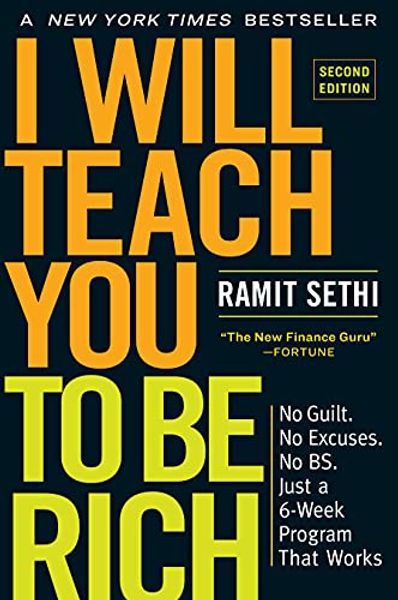I will Teach You To Be Rich - Ramit Sethi

I Will Teach You to Be Rich is Ramit Sethi’s way of helping the average joe become rich. He outlines actionable steps in each chapter that will help anyone take control of their finances.
Ramit simplifies investing for beginners who are just starting and helps set up a system that will be easily maintained over the long term. He truly provides an easy approach to getting rich in the long term while enjoying a rich life in the present time.
Here I will outline the topics that resonated with me the most. However, there are a few more valuable lessons to be learned from reading the full book.
Being “Rich” is Different for Everyone

Everyone’s perspective of being "rich" is different. Some want big houses, others want fancy vacations, while you may want to never work again.
It is important to define what being rich means to you so you can get there faster. Being rich doesn't necessarily mean having an abundant amount of money.
It is more about freedom of choice. The choice to work from home, spend lavishly when dining out, take long vacations, and spend more time with family.
All these choices have to do with money, but they are not tied to a specific amount of money. Do not let a number define what being rich means to you.
Aim for Big Wins

If you know Stephan Graham from YouTube, you know that he cringes every time someone spends $5 on a Starbucks coffee every day.
Ramit, on the other hand, tells you to buy that coffee if it is going to bring you joy. In his eyes, that is a small win. Instead, he emphasizes focusing on big wins.
For instance, picking the right bank so they don’t feed off you by charging you ridiculous amounts of fees is crucial.
Another one is maximizing your 401(k) contributions. Using your credit cards for everyday purchases to maximize points and cash back is another big win. Cancelling subscriptions you don’t use will save you tons of money in the long run.
Lastly, consider negotiating a raise to increase your income and allocate more towards savings.
Those are all examples of big wins that will have a larger impact in the long run.
Be a Conscious Spender

Do not confuse being a conscious spender with being cheap. Ramit’s idea of being rich is to invest for the future while continuing to enjoy spending your money now.
But first, you need a spending plan that allocates your money wisely. A spending plan is one that allocates your monthly income in a similar way to this:
- Fixed Costs (50%)
- Savings (10%)
- Investing (20%)
- Guilt-free spending (20%)
In order to do that, you have to cut all your unnecessary spending. With those savings, you now have a sizable portion of your income to spend on guilt-free purchases.
Well, what are the guilt-free items? That definition is up to you to define.
It can be anything you enjoy spending on regardless of price, such as designer clothes, 5-star hotels, or business class tickets. Anything that you truly enjoy.
Automate Your Money System

Learning how to automate your finances is the most crucial lesson to setting up your future for financial success.
Ramit explains how most people fail in their finances because they are too lazy to learn about them. They find excuses to justify why they are in debt or living paycheck-to-paycheck.
Which is why he breaks down how money should be allocated the moment it hits your checking account.
Most people have a checking account that serves as their money stash, which is why they end up depleting it by the end of the month. Instead, think of your checking account as a distribution center for all your other accounts.
Once the money goes into your checking account, there should be a system in place that distributes it to the following accounts:
- Expense account (fixed monthly spending)
- Savings account (short-term goals)
- Emergency fund
- Accounts for retirement investing (401k, Roth IRA, and taxable accounts)
- Debt payoff (credit cards, student loans, etc.)
Set up automatic distributions so that it becomes effortless and decreases the amount of time you spend on your finances every month.
Be a Passive Investor

Many people shy away from investing because they think investing is hard and they will lose their money.
However, Ramit explains the difference in investing strategies and how they can make anyone rich with minimal effort.
Investor type 1: The first investor is one that chooses their own stocks and bonds (active investing). This investment strategy is not recommended for the majority of people. It has been proven extremely difficult to beat the stock market over a period of 20 years.
Investor type 2: The second investor is one that chooses low-cost index funds and mutual funds (passive investing). These funds are essentially a pie of many stocks and bonds that are chosen and managed by financial experts to track the stock market's performance.
Investor type 3: The third investor is one that chooses target date funds (passive investing). This strategy is simple since you choose a target fund for the year you plan to retire. So if you plan on retiring in 2060, you should choose "target retirement 2060". The fund invests in risky assets aimed at growth when you are young and adjusts to low-risk investments as you get older and closer to retirement to preserve your money.
You may have noticed that in those passive investing strategies, there is no hassle. You allocate money and the funds distribute it into respective stocks and bonds.
All you have to do is sit back and watch compound interest grow your money for you.
Bottom Line
Being rich is different for everyone. You have to decide what being rich means to you and work towards it.
Getting rich is not as hard as people think. If you implement the right strategies and systems laid out by Ramit, you will live a happy, rich life now while building wealth for retirement.
Focus on the big wins, eliminate unnecessary spending, and consistently invest your money to enjoy a rich life now and later down the road.

